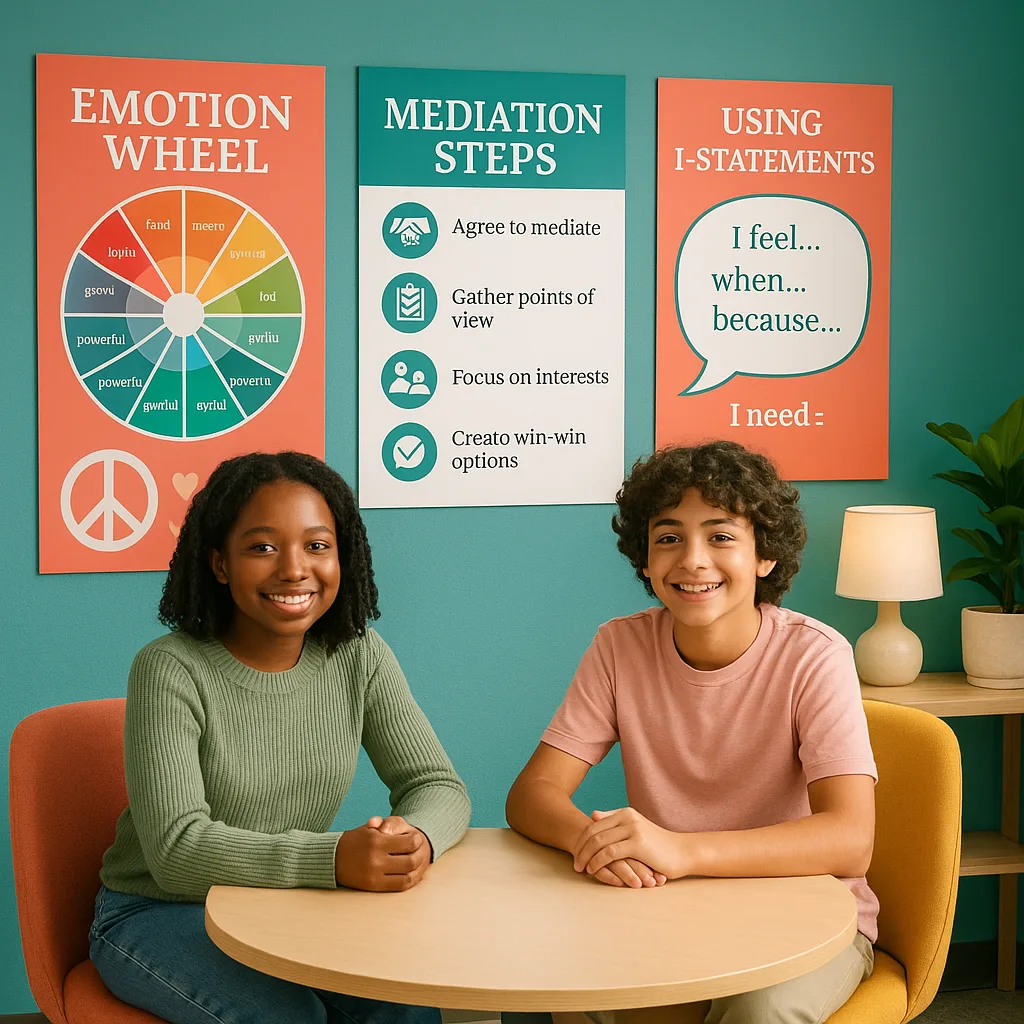Classroom Poster Maker for Peer Mediation Stations
Hey there, amazing educators! Let me share something that happened in my classroom last week that totally changed how I think about student conflict resolution. Picture this: two of my seventh-graders were in a heated argument over a group project. Instead of jumping in to mediate, I watched as our trained peer mediators calmly guided them to our new mediation station. Using the visual guides we’d created with our classroom poster maker peer mediation system, these student leaders facilitated a peaceful resolution in under ten minutes. Mind. Blown.
This experience reinforced what I’ve been discovering all year—when we give students the right visual tools and frameworks, they become powerful agents of change in their own community. Today, I’m excited to share how you can create comprehensive mediation stations that empower your student leaders to transform conflict into connection.
Building Your Classroom Poster Maker Peer Mediation Station
Creating an effective mediation station starts with understanding the key components students need to guide successful peer conversations. Through trial and error (and lots of student feedback!), I’ve identified five essential poster elements that transform any corner of your classroom into a peace-building powerhouse.
The Mediation Process Map serves as your visual roadmap. This isn’t just a list of steps—it’s a colorful, engaging journey that shows students exactly how to move from conflict to resolution. I design mine with arrows, icons, and student-friendly language that makes each phase crystal clear. For example, instead of “Establish ground rules,” my poster says “Set the Peace Promise” with visual reminders like listening ears and respectful speech bubbles.
Emotion Regulation Visuals are absolute game-changers. These posters help students identify and manage their feelings before diving into problem-solving. I create a “Feelings Thermometer” that ranges from “Chill” to “Boiling Over,” with specific calming strategies at each level. Students can literally point to where they are emotionally and find immediate coping tools.
Active Listening Anchors provide visual cues for one of the hardest skills in mediation—truly hearing each other. My posters include body language reminders, paraphrasing prompts, and even “magic phrases” like “What I heard you say is…” that keep conversations on track.

Designing Restorative Question Prompts That Actually Work
One of the biggest breakthroughs in my mediation station came from reimagining how we present restorative questions. Instead of dense text, I create visual question cards that student mediators can literally hold up or point to during sessions. Each question is paired with an icon and color-coded by purpose.
For instance, “understanding” questions appear in calming blue with an ear icon, while “accountability” questions use orange with a mirror symbol. This visual coding helps mediators know exactly which type of question to use at different points in the conversation. My students especially love the “perspective flip” cards that show the same situation from two different viewpoints—it’s like a visual empathy builder!
The beauty of using a quality poster printer for these materials is the durability factor. When emotions run high, papers can get crumpled or torn. But laminated posters created with our Campus Pro 36 Poster Maker stay pristine session after session, maintaining that professional, neutral presence students need.
Question Categories
Organize prompts by purpose: Understanding, Reflection, Action PlanningImplementation Tips
Create a “question menu” where mediators can select prompts based on where the conversation needs to go. Include sentence starters like “Help me understand…” or “What would it look like if…” to make facilitation feel natural, not scripted.Real Talk: Budget-Friendly Implementation Strategies
I know what you’re thinking—”This sounds amazing, but what about the cost?” Here’s the truth: investing in quality visual materials actually saves money in the long run. When I first started creating mediation stations, I was printing everything on regular paper and constantly replacing torn or faded materials. The game-changer came when our school invested in a proper poster printing solution.
Let me break down the real numbers. The poster printer price might seem daunting initially, but when you calculate the cost per poster over the printer’s lifetime, it’s incredibly economical. Our Classroom Pro 24 Poster Maker Elite Package paid for itself within the first year just from what we saved on outsourcing. Plus, being able to update and customize our mediation materials instantly means we can respond to student needs in real-time.
For schools just starting out, consider pooling resources with other classrooms or applying for funding through various grant programs. Many SEL-focused grants specifically support peer mediation initiatives. I’ve also seen PTOs enthusiastically fund these programs once they understand the impact on school climate.
Another budget hack? Start with a core set of essential posters and build your collection gradually. Focus first on the mediation process map and basic emotion regulation tools. As your program grows and proves its worth (which it will!), expanding becomes easier to justify and fund.
Ready to Transform Conflict into Connection?
Creating a visual peer mediation program isn’t just about pretty posters—it’s about empowering students to become peacemakers in their own community. When we provide the right visual frameworks, something magical happens. Students who once avoided conflict or escalated it unnecessarily begin to see disagreements as opportunities for growth and understanding.
The investment in quality printing equipment, whether you’re considering poster printer price options or starting with basic materials, pays dividends in reduced disciplinary issues, improved classroom climate, and most importantly, students who feel capable of solving their own problems.
Start small if you need to. Create one mediation station. Train a handful of student mediators. Use whatever printing resources you have available initially. But dream big about what’s possible when visual learning meets social-emotional growth. Your students are ready to lead—they just need the right tools to show them the way.
Remember, every peaceful resolution started with someone believing young people could handle hard conversations. With the right visual supports from a classroom poster maker peer mediation system, they absolutely can. Here’s to less time managing conflicts and more time celebrating the incredible problem-solvers in your classroom!
Next Steps:

